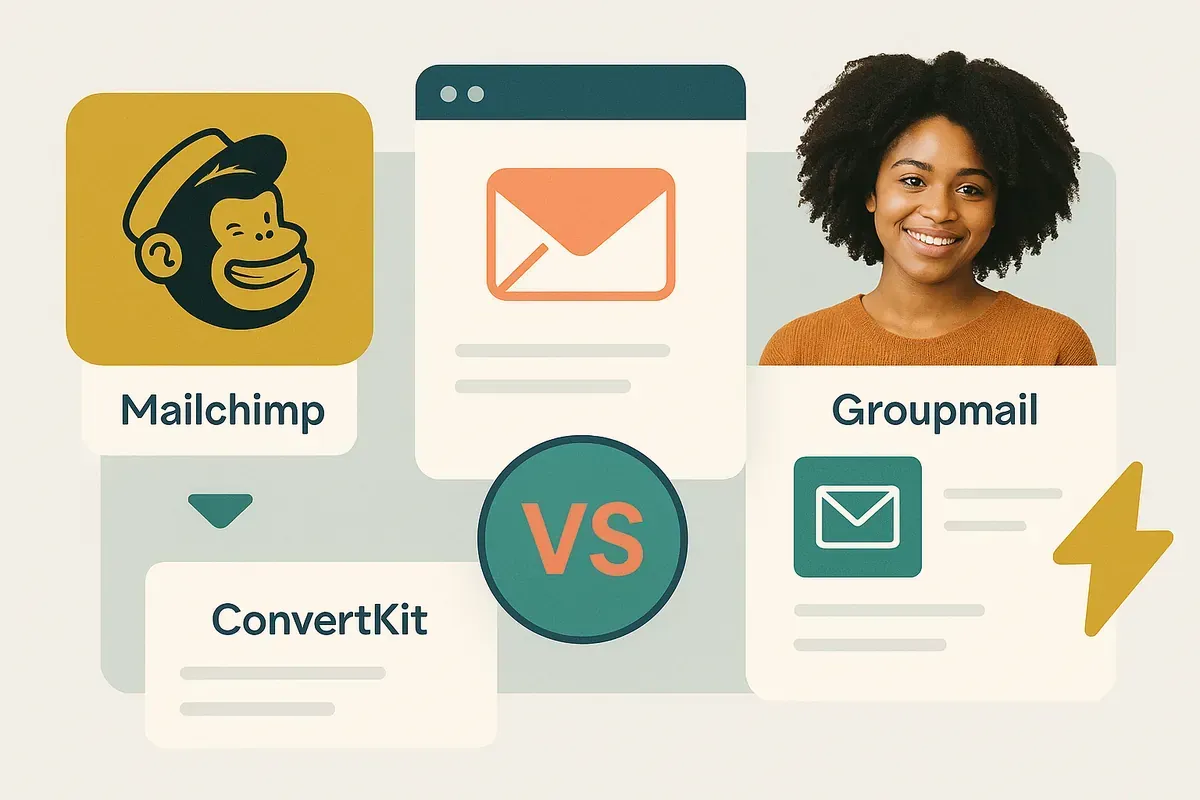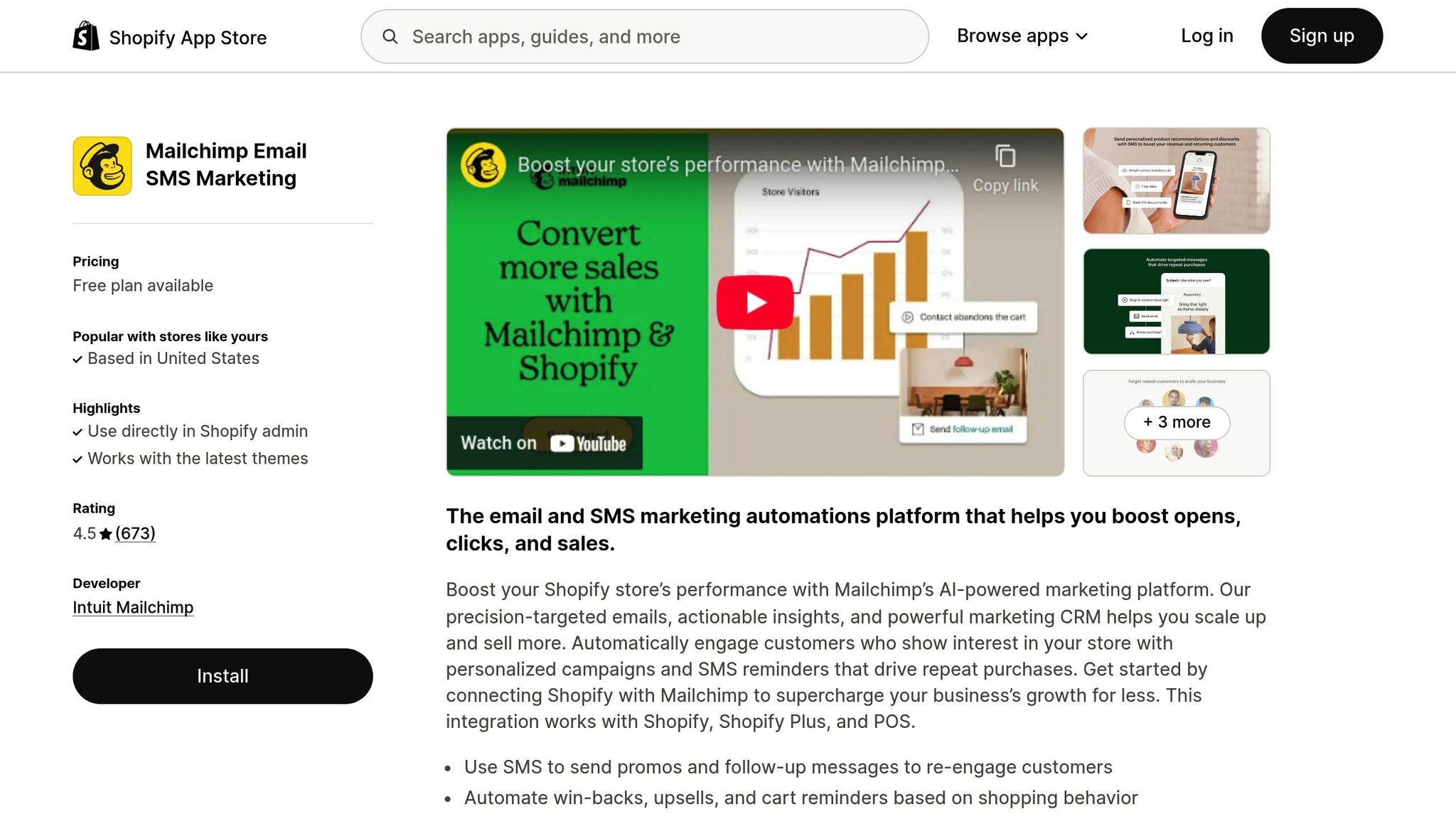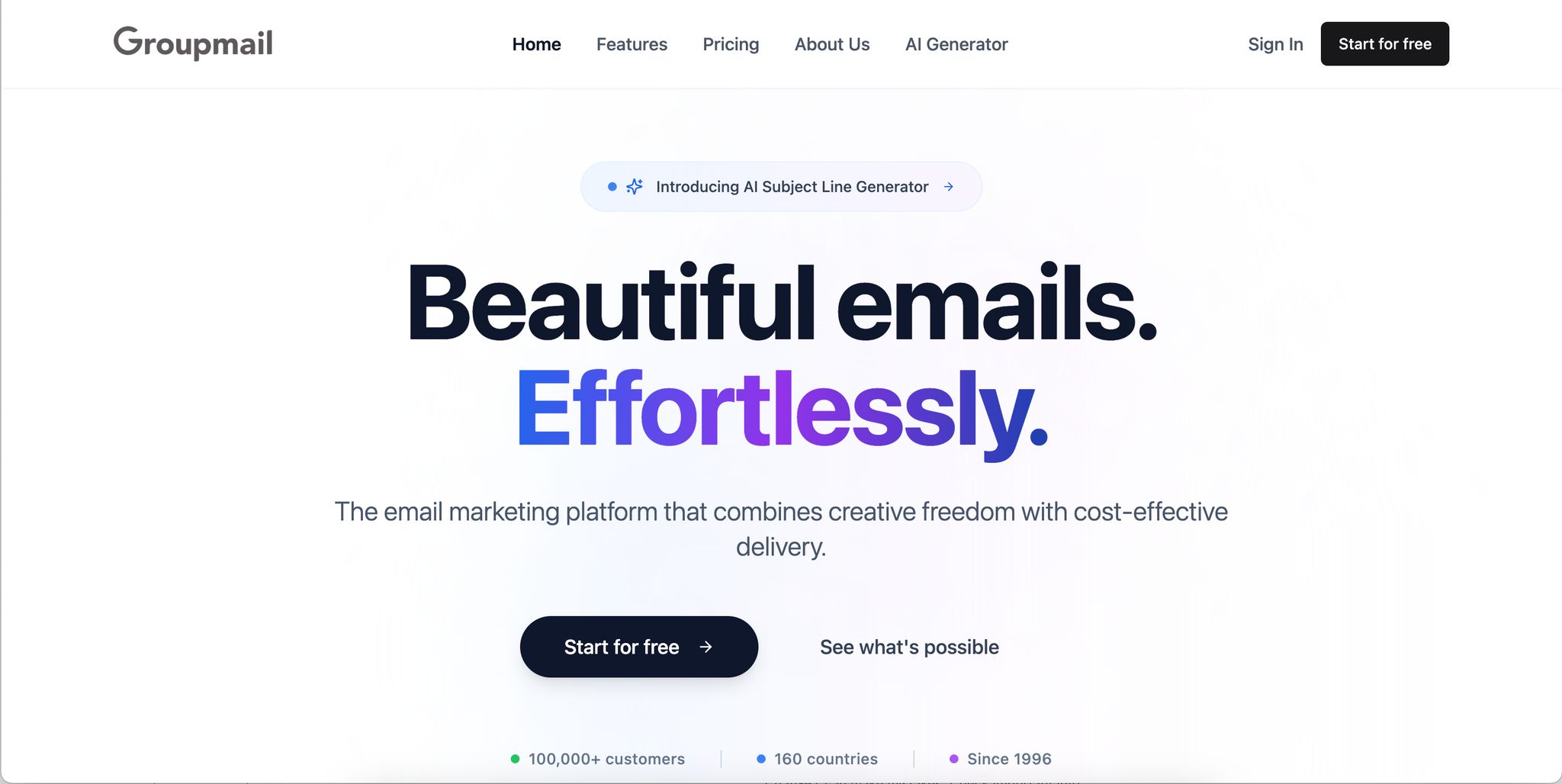Mailchimp vs ConvertKit vs Groupmail: Which Is Best in 2025?
Explore the best email marketing platforms in 2025, comparing features, pricing, and usability to find the right fit for your business needs.

Choosing the right email marketing platform in 2025 comes down to your needs and budget. Here’s a quick breakdown of the top contenders:
- Mailchimp: Best for larger businesses with complex marketing needs. Offers advanced tools, integrations, and analytics but comes with higher costs.
- ConvertKit: Tailored for content creators like bloggers and course makers. Simple, effective tools with competitive pricing, including a free plan for up to 10,000 subscribers.
- Groupmail: Perfect for small teams and budget-conscious users. Affordable plans with unlimited sending, user-friendly design, and essential features.
Quick Comparison
| Platform | Best For | Free Plan Details | Paid Plans Start At | Key Features |
|---|---|---|---|---|
| Mailchimp | Larger businesses | 500 contacts, 1,000 emails/month | $13/month | Advanced automation, analytics, integrations, higher-tier costs |
| ConvertKit | Content creators | 10,000 subscribers, unlimited sends | $29/month | Automation, tagging, free migration, unlimited sends |
| Groupmail | Small teams, low budget | 1,000 contacts, 2,000 sends/month | $10/month | Unlimited sends, drag-and-drop builder, AI tools, real-time analytics |
Key Takeaway:
If you need advanced features and have the budget, Mailchimp is ideal. For creators, ConvertKit offers simplicity and creator-focused tools. Groupmail is the go-to for affordability without sacrificing core features.
Mailchimp vs ConvertKit | Which One is Better in 2025?

Ease of Use: How Simple Is Each Platform?
When selecting an email marketing platform, how easy it is to set up and use daily can make a big difference in your overall experience. From onboarding to campaign creation, each platform offers a unique approach to user experience. Here's a breakdown of how each one fares in terms of usability.
Mailchimp: Feature-Rich, But Can Be Overwhelming
Mailchimp is a web-based application, so you can access it via any browser without needing to install software. Setting up an account is straightforward, with a guided process that walks you through creating your first "audience" (Mailchimp's term for email lists), linking social media accounts, and setting up website integrations. While this structured onboarding can be helpful, it might feel overwhelming for those who just want to send a simple newsletter.
For users on paid Marketing plans, Mailchimp offers 1:1 consultations with onboarding specialists to help navigate its more advanced features. The platform is designed around managing a single audience with specific organizational tools. However, this setup might feel limiting for those who need more flexibility in managing multiple lists.
If Mailchimp feels a bit too complex, ConvertKit offers a more streamlined option for creators.
ConvertKit: Tailored for Content Creators
ConvertKit strikes a balance between simplicity and functionality, making it a go-to choice for bloggers, podcasters, and online course creators. Its standout features include automation workflows and subscriber tagging, which make it easier to build personalized email sequences. The platform’s visual automation builder is a highlight, allowing users to map out how their emails will flow in a clear, intuitive way.
While ConvertKit is simpler than Mailchimp in some respects, it does come with a learning curve. Users need to get comfortable with concepts like automation and tagging to fully unlock its potential.
Groupmail: Streamlined and Beginner-Friendly

Groupmail - Smarter Email Marketing
Groupmail takes a straightforward approach to email marketing. As a cloud-based platform, it’s accessible online and features a drag-and-drop email builder that ensures a quick and easy start, even for beginners. The interface keeps things simple by focusing on the essentials: building emails, managing contacts, and tracking results. You won’t have to dig through layers of advanced settings to find what you need.
Despite its simplicity, Groupmail doesn’t skimp on features. It includes real-time analytics, mobile-optimized templates, and built-in image editing tools. For those who want more flexibility, it also offers advanced options like video and HTML blocks. Additional perks include multi-language support, seamless SMTP integration, and a free AI email subject line generator to help you craft attention-grabbing campaigns.
Whether you’re a solo creator launching your first newsletter or a small team managing multiple campaigns, Groupmail keeps things simple while offering enough tools to handle more complex needs. It’s user-friendly without sacrificing functionality.
Features: What Each Platform Includes
The features offered by each email marketing platform play a major role in determining their overall usefulness. Choosing the right set of tools can make a big difference in how effectively you connect with your audience.
Mailchimp: Comprehensive Tools and Integrations
Mailchimp provides a wide range of email marketing tools, including automation, AI-driven features, and in-depth analytics. It also supports a large number of third-party app integrations, making it easy to connect with other software. However, advanced tools are only available on higher-tier plans. Pricing scales by contacts and varies by region/currency — see Mailchimp’s compare-plans page for current details: https://mailchimp.com/pricing/marketing/compare-plans/.
ConvertKit: Designed for Creators
ConvertKit focuses on helping content creators grow their audience with features like automation and targeted messaging. Its tagging system allows users to segment subscribers and send personalized emails effectively. The platform now offers a free Newsletter plan for up to 10,000 subscribers (includes one basic visual automation and one sequence), plus free migration for lists with 5,000+ subscribers. See pricing and plan details: https://kit.com/pricing and https://help.kit.com/en/articles/9053602-the-kit-newsletter-plan.
Groupmail: Affordable and Scalable Email Solutions
Groupmail is an excellent choice for small teams or marketers working with limited budgets. It offers features like responsive email designs, video/HTML blocks, a built-in image editor, real-time analytics, and unlimited sending on paid plans. Additional tools include bounce and unsubscribe management, email scheduling and even a free AI email subject line generator (link). Hosting is based in Ireland for added data security, and SMTP integration is seamless. Pricing starts with a free plan for 1,000 contacts (2,000 sends/month). The Individual plan is $10/month for 10,000 contacts, while the Business plan costs $29/month for 50,000 contacts. Both paid plans include full feature access and come without Groupmail branding.
Email Delivery: How Well Do Emails Reach Inboxes?
Getting your emails into the inbox instead of the spam folder is critical. Recent industry benchmarks put average global inbox placement around 85–86% — roughly one in six legitimate messages never reaches the inbox. Focus on authentication (SPF, DKIM, DMARC), gradual warm-ups, and list hygiene to improve placement.
Source: Validity 2023 Benchmark (PDF): https://www.validity.com/wp-content/uploads/2023/03/2023-Email-Deliverability-Benchmark.pdf.
Mailchimp: Reliable Delivery Backed by Smart Tools
Mailchimp puts a lot of effort into ensuring your emails land where they should. Its Omnivore algorithm is designed to predict issues like bounces or permission problems before you even send your campaign. Plus, it automatically handles bounced emails and spam complaints, helping protect your sender reputation.
Mailchimp enforces strict anti-spam measures, requiring unsubscribe links and physical addresses in every email. It also supports DKIM and DMARC authentication, and for high-volume senders, it offers dedicated IP addresses for added control. To top it off, Mailchimp prohibits shady practices like using purchased email lists or misleading content, keeping its platform clean. Its reporting tools provide detailed insights into how your emails perform across different providers.
ConvertKit: Tailored Delivery for Content Creators
ConvertKit (now simply Kit) focuses on creators' needs and delivers strong results.
ConvertKit actively protects sender reputation by managing SPF and DKIM authentication and addressing delivery issues through feedback loops. The platform also works hard to block spammers, ensuring its users maintain a good reputation. Best practices like double opt-in subscriptions, proper list segmentation, and sending from verified domains are encouraged, making it a solid choice for creators looking to connect with their audience.
Groupmail: Affordable Delivery with Real-Time Insights
You can connect seamlessly to trusted providers like SMTP2GO (partner perk: 10,000 free emails/month — details: https://groupmail.io/kb-article?slug=setting-up-groupmail-with-smtp2go) or SendGrid. Both providers offer advanced delivery options — including dedicated IPs, authentication, and security controls — so you can manage deliverability in the way that best suits your business.
Groupmail automatically handles bounces and unsubscribes, and adds unsubscribe links to every campaign to keep you compliant with anti-spam laws. Real-time analytics give you immediate insight into campaign performance, while hosting in Ireland ensures strong data protection with SSL and encryption.
Each platform brings something unique to the table, making it easier to find the right fit for your email marketing needs.
Pricing: Which Platform Offers the Best Value?
When picking an email platform, pricing often becomes a deciding factor. Each service has its own pricing structure, and what seems affordable at first can quickly add up as your subscriber list grows. Here’s a look at how three popular platforms compare in USD.
Mailchimp: Higher Costs for Advanced Features
Mailchimp’s free plan is appealing at first glance, offering support for up to 500 contacts and 1,000 email sends per month. However, it comes with a daily sending limit of 500 emails and only basic automation capabilities.
Once you move beyond the free tier, costs increase with your contact count. Essentials includes automation flows with up to 4 steps (source: https://mailchimp.com/help/about-customer-journeys/). Also note: Mailchimp counts subscribed, non-subscribed and unsubscribed contacts toward your contact limit (source: https://mailchimp.com/help/about-your-contacts/), which can inflate costs if you don’t archive inactive records. Always confirm current pricing on the official page: https://mailchimp.com/pricing/marketing/.
ConvertKit: A Creator-Friendly Option
ConvertKit (now branded as Kit) offers pricing that’s especially appealing for creators. Its free "Newsletter" plan allows up to 10,000 subscribers with unlimited email sends, along with access to forms, landing pages, and one automated sequence.
Upgrading to a paid plan is straightforward, as pricing is based solely on subscriber count while still allowing unlimited sends at every level. While the free plan includes transaction fees for selling digital products and requires enabling a recommendation feature, the overall pricing model is simple and transparent.
Groupmail: Budget-Friendly with Unlimited Sending
For those looking for affordability without sacrificing features, Groupmail stands out. Its free plan supports 1,000 contacts and 2,000 monthly sends, though emails include Groupmail branding.
The Individual plan, priced at just $10 per month, allows up to 10,000 contacts with unlimited sends and removes branding. For larger campaigns, the Business plan costs $29 per month and supports 50,000 contacts with unlimited sends. Groupmail’s predictable pricing makes it an excellent choice for businesses aiming to send frequent emails without worrying about overage fees.
Best Use Cases: Which Platform Fits Your Business?
Choosing the right email marketing platform depends on your business size, team setup, and marketing objectives. Here's a breakdown of the best use cases for each platform.
Mailchimp: Ideal for Larger Businesses
Mailchimp is a great fit for established businesses with dedicated teams, especially those managing multiple campaigns and intricate customer journeys.
E-commerce businesses will find Mailchimp particularly useful, thanks to its seamless integrations with platforms like Shopify, WooCommerce, and BigCommerce. Its advanced segmentation tools allow retailers to create highly targeted campaigns based on factors like purchase history and browsing behavior.
For companies with complex automation needs, Mailchimp's workflow builder is a standout feature. Whether you're setting up multi-step nurture sequences, abandoned cart reminders, or behavioral-triggered emails, this platform can handle it. Add to that its detailed analytics and A/B testing capabilities, and you’ve got a tool that supports data-driven decision-making and stakeholder reporting.
If your business requires sophisticated automation and in-depth analytics, Mailchimp is a solid choice.
ConvertKit: Perfect for Individual Creators
ConvertKit is designed with content creators in mind, offering streamlined tools for delivering lead magnets, welcome emails, and nurture sequences.
Creators of online courses and coaching programs often rely on ConvertKit’s tagging system to track subscriber progress. Its smooth integration with course platforms makes it easy to deliver materials directly via email.
With a subscriber-based pricing model and unlimited email sends, ConvertKit is a cost-effective option for creators who send frequent updates, such as daily newsletters or regular content.
For creators looking for simplicity and functionality tailored to their needs, ConvertKit is a smart pick.
Groupmail: Budget-Friendly for Small Teams
Groupmail caters to small businesses and marketers who need reliable email marketing without breaking the bank. Its unlimited sending model is particularly appealing for teams that communicate frequently with their audience.
Small agencies and consultants benefit from Groupmail’s user-friendly drag-and-drop builder, mobile-optimized templates, and real-time analytics.
Startups will appreciate the affordability of Groupmail’s plans, starting at just $10 per month for up to 10,000 contacts with unlimited sends. This allows teams to focus on growth without worrying about escalating costs.
With essential features like personalization, and detailed reporting, Groupmail is an excellent choice for small to medium-sized businesses looking to manage high-volume communications on a budget.
For teams prioritizing affordability and simplicity, Groupmail delivers reliable performance without the premium price tag.
Final Decision: Choosing Your Email Platform in 2025
After exploring the features, pricing, and usability of these platforms, your choice ultimately depends on your budget, business size, and specific requirements. Each platform shines in different ways, catering to a variety of needs.
Mailchimp is a powerhouse for established businesses with complex marketing demands. With over 300 integrations and an extensive suite of tools, it’s well-suited for managing intricate campaigns. That said, its advanced features come with higher costs and potential extra charges.
ConvertKit, on the other hand, is tailored for creators. It offers affordable plans and a free option for up to 10,000 subscribers, allowing unlimited broadcast emails. Its subscriber-centric model prevents duplicate charges for the same email across forms and landing pages (source: https://help.kit.com/en/articles/2502716-what-does-subscriber-centric-mean), making it a smart choice for content creators focused on growing and monetising their audience.
Groupmail provides a budget-friendly option without skimping on essential features. For just $10/month, you get support for 10,000 contacts and unlimited email sends. It’s ideal for small teams or growing businesses, offering tools like AI-assisted features, real-time analytics, and mobile-optimized templates. Its straightforward design makes it a scalable and user-friendly choice.
When deciding, think about where your business is headed. If you’re anticipating rapid growth, ConvertKit’s subscriber-based model with unlimited sending can help you avoid surprise costs. For businesses that need advanced automation and detailed reporting, Mailchimp’s robust toolset may justify the extra investment. Meanwhile, if you’re a smaller team focused on managing costs while maintaining consistent communication, Groupmail’s affordability and simplicity are hard to beat.
Each platform comes with its own learning curve. Mailchimp’s expansive features may take time to master, while ConvertKit focuses on simplifying the creator experience. Groupmail strikes a middle ground, offering an intuitive interface that won’t overwhelm new users.
Ultimately, the best platform is the one that fits your current needs and can grow with you. Whether you’re a marketer watching your budget, a content creator building engagement, or a larger business in need of advanced tools, there’s an option here to meet your goals for 2025.
FAQs
How do the pricing models of Mailchimp, ConvertKit, and Groupmail compare?
Mailchimp offers a tiered pricing structure, starting with a free plan for up to 500 contacts. If you need more, their paid plans kick off at $13/month for 500 contacts, with costs rising as your subscriber base expands.
ConvertKit, on the other hand, begins at $2/month for up to 1,000 subscribers. As you move up the pricing tiers, you gain access to more advanced features.
Groupmail takes a different approach with its flat-rate pricing model, which can be easier on the budget. They provide a free plan that supports up to 1,000 contacts and allows for 2,000 emails per month. Paid plans start at $10/month for small teams, with options scaling up to $29/month for those needing more advanced capabilities. This straightforward pricing makes Groupmail a solid pick for small businesses, startups, and marketers seeking an affordable and flexible email marketing solution.
How does email deliverability compare between Mailchimp, ConvertKit, and Groupmail, and what factors impact success rates?
Email deliverability is crucial for making sure your messages actually land in your audience's inboxes. In 2025, Mailchimp continues to shine with its impressive inbox placement rates. Performance stems from their advanced infrastructure and years of fine-tuning.
ConvertKit also stands out for its focus on deliverability. By using strategies like tag-based segmentation and offering single opt-in options, it helps users maintain a solid sender reputation - key for getting emails where they’re supposed to go.
Meanwhile, Groupmail highlights the importance of factors like sender reputation, proper email authentication (SPF, DKIM, DMARC), and keeping your contact lists clean and engaged. Although specific deliverability stats for Groupmail aren't widely shared, sticking to these best practices ensures dependable results across campaigns.
In the end, the success of these platforms hinges on their ability to handle technical protocols effectively and maintain trust with email providers.
What is the best email platform for a small business looking to grow its marketing efforts over time?
For small businesses looking to expand their email marketing efforts, ConvertKit is a solid option. It’s built with creators and growing audiences in mind, offering tools that make scaling up easier. Another great choice is Groupmail, which combines a user-friendly interface with dependable features tailored specifically for small to medium-sized businesses. While Mailchimp is packed with a variety of tools, both Groupmail and ConvertKit shine for their straightforward approach and growth-focused features, making them perfect for businesses that want to scale at a steady pace.




